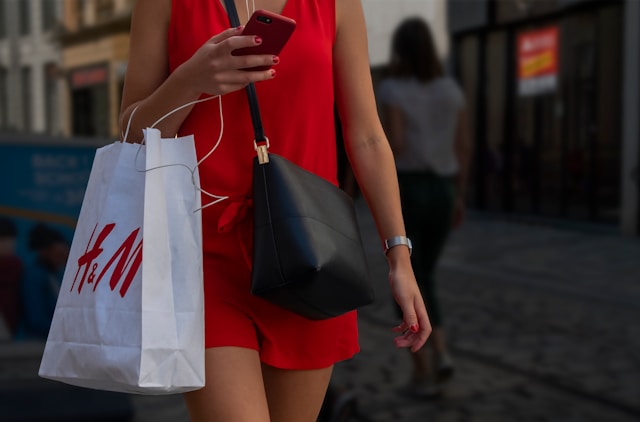H&M stands out as a prominent player in global fashion retail. The Swedish multinational, known for offering trendy and affordable apparel, has crafted a marketing strategy that has been integral to its success. This post looks at the key aspects of H&M’s marketing approach, illustrating how the brand maintains its position in a competitive market through innovative campaigns, digital transformation, sustainability efforts, and a deep understanding of its customer base.
Brand Identity and Market Positioning
H&M, or Hennes & Mauritz, started in 1947 and has grown into one of the largest fashion retailers in the world. The brand’s core identity revolves around providing fashionable and affordable clothing for all. H&M targets a broad demographic, from teenagers to middle-aged adults, ensuring inclusivity in its product lines.
One of H&M’s critical strategies is its ability to quickly adapt to fashion trends. The brand’s designers and trend scouts are adept at identifying emerging styles and translating them into affordable collections. This fast-fashion model allows H&M to continuously update its inventory, keeping the merchandise fresh and relevant.

Digital Transformation and Omnichannel Strategy
H&M has embraced digital transformation wholeheartedly. The brand understands that a strong online presence is crucial in today’s retail environment. H&M’s website and mobile app offer seamless shopping experiences, featuring intuitive navigation, personalized recommendations, and user-friendly interfaces.
The company’s omnichannel strategy ensures a cohesive experience across various platforms. Customers can shop online, pick up their purchases in-store, or have them delivered to their homes. This integration of online and offline channels enhances convenience and flexibility for shoppers.
Social Media Engagement
H&M leverages social media to connect with its audience and drive engagement. The brand is active on platforms like Instagram, Facebook, Twitter, and TikTok, where it shares content that resonates with its target market. From showcasing new collections and collaborations to featuring user-generated content, H&M’s social media strategy is dynamic and interactive.
A notable example is the #HMxMe campaign, where customers were encouraged to share photos of themselves wearing H&M clothing. This campaign not only boosted engagement but also created a sense of community among H&M shoppers. By featuring customer photos on its social media channels, H&M fostered a more personal connection with its audience.
Influencer Collaborations
Collaborations with influencers and celebrities have been a significant part of H&M’s marketing strategy. These partnerships help the brand reach wider audiences and create buzz around new collections. H&M has worked with various influencers and celebrities, including Beyoncé, David Beckham, and Kendall Jenner, to name a few.
One standout collaboration was with the fashion designer Alexander Wang. The H&M x Alexander Wang collection generated immense excitement and was promoted through a combination of traditional and digital marketing efforts. The collaboration was a massive success, with products selling out almost immediately.

Sustainability Initiatives
In recent years, sustainability has become a focal point for H&M. The brand is aware of the growing consumer demand for environmentally responsible practices and has made significant strides in this area. H&M’s sustainability strategy includes using more sustainable materials, improving supply chain transparency, and encouraging recycling.
The Conscious Collection is a testament to H&M’s commitment to sustainability. Launched in 2010, this line features clothing made from organic cotton, recycled polyester, and other sustainable materials. The collection is promoted through various marketing channels, emphasizing H&M’s dedication to reducing its environmental impact.
Additionally, H&M’s garment recycling program invites customers to bring unwanted clothes to their stores in exchange for discounts. This initiative not only promotes recycling but also strengthens customer loyalty.
Experiential Marketing
H&M also invests in experiential marketing to create memorable experiences for its customers. Pop-up shops, in-store events, and fashion shows are some ways the brand engages with its audience on a more personal level.
For example, H&M has hosted several pop-up events to launch new collections or collaborations. These events generate excitement and allow customers to interact with the brand in unique settings. By creating buzz and offering exclusive experiences, H&M enhances its brand appeal and customer engagement.
Data-Driven Marketing
H&M utilizes data-driven marketing to better understand its customers and tailor its strategies accordingly. By analyzing customer data, the brand can identify shopping patterns, preferences, and trends. This information is used to optimize inventory, personalize marketing messages, and improve the overall shopping experience.
For instance, H&M’s loyalty program, H&M Club, collects data on members’ shopping behaviors. This data is then used to offer personalized discounts, recommendations, and exclusive offers, enhancing customer retention and satisfaction.
Global Advertising Campaigns
H&M’s global advertising campaigns are another critical aspect of its marketing strategy. These campaigns are designed to appeal to diverse audiences across different markets. H&M’s advertisements often feature a mix of well-known celebrities, models, and everyday people, reflecting the brand’s inclusive approach.
One notable campaign was the 2016 “She’s a Lady” ad, which celebrated women of various ages, sizes, and ethnicities. The campaign, set to the song “She’s a Lady” by Tom Jones, emphasized empowerment and diversity, resonating with a wide audience.
Store Design and Visual Merchandising
H&M places a strong emphasis on store design and visual merchandising to attract customers and enhance the shopping experience. The brand’s stores are designed to be inviting, with clear layouts and attractive displays that showcase the latest trends.
Visual merchandising plays a crucial role in driving sales. H&M’s window displays are often eye-catching and themed around current collections or campaigns. In-store, mannequins and displays are strategically placed to highlight new arrivals and encourage impulse purchases.
Strategic Collaborations and Partnerships
H&M’s strategic collaborations extend beyond fashion designers and celebrities. The brand also partners with various organizations and initiatives to enhance its brand image and reach new audiences.
For example, H&M has collaborated with UNICEF on several occasions to support children’s education and development programs. These partnerships not only contribute to social good but also enhance H&M’s reputation as a socially responsible brand.
Challenges and Adaptations
Despite its success, H&M faces challenges common to the fast-fashion industry, including criticism over labor practices and environmental impact. The brand has taken steps to address these issues, such as increasing transparency in its supply chain and committing to more sustainable practices.
H&M has also adapted to changing consumer behaviors and market conditions. The COVID-19 pandemic, for instance, accelerated the shift towards e-commerce, and H&M responded by enhancing its online presence and digital capabilities.
H&M’s marketing strategy is a multifaceted approach that combines digital transformation, social media engagement, influencer collaborations, sustainability efforts, and experiential marketing. The brand’s ability to adapt to trends and understand its customers has been crucial to its success.
Marketing professionals can draw inspiration from H&M’s strategic use of data, innovative campaigns, and commitment to sustainability. By staying agile and responsive to market changes, H&M continues to thrive in the competitive fashion industry, setting a benchmark for others to follow.
Examples of H&M’s Marketing Campaigns
To illustrate H&M’s marketing prowess, let’s take a closer look at some of their standout campaigns.
H&M x Moschino
In 2018, H&M launched a collaboration with the Italian luxury brand Moschino. The collection, designed by Moschino’s creative director Jeremy Scott, was a blend of pop culture and street style. The campaign featured bold, colorful advertisements with celebrity endorsements from Gigi Hadid and Bella Hadid.
The collection was promoted through various channels, including social media teasers, influencer previews, and a high-energy fashion show. The campaign’s success was evident as the collection sold out within hours of its release, demonstrating the power of strategic partnerships and effective marketing.
“Close the Loop” Campaign
In 2015, H&M launched the “Close the Loop” campaign to promote its garment recycling program. The campaign featured a diverse cast of models and emphasized the importance of sustainability in fashion. The message was clear: fashion has no rules, but it must be sustainable.
The campaign included a short film that was shared on social media and played in stores worldwide. It encouraged customers to recycle their old clothes and highlighted H&M’s commitment to creating a more sustainable fashion industry. The campaign was well-received and helped to position H&M as a leader in sustainable fashion.
Balmain x H&M
The Balmain x H&M collaboration in 2015 was another significant campaign that created a frenzy among fashion enthusiasts. Designed by Balmain’s creative director Olivier Rousteing, the collection featured luxurious, high-fashion pieces at accessible prices.
The campaign was promoted through a star-studded event in New York City, with a runway show featuring top models like Kendall Jenner and Gigi Hadid. Social media played a crucial role in building anticipation, with sneak peeks and behind-the-scenes content shared in the lead-up to the launch. The collection was a massive hit, with items selling out almost immediately.
Digital Innovations and Future Trends
H&M continues to innovate in the digital space, exploring new technologies and platforms to enhance customer engagement. The brand has experimented with virtual reality (VR) and augmented reality (AR) to create immersive shopping experiences. For example, H&M has used AR to enable customers to see how products would look in their own homes before making a purchase.
Looking ahead, H&M is likely to further integrate AI and machine learning into its operations. These technologies can help optimize inventory management, personalize marketing efforts, and improve the overall shopping experience.
What Make’s H&M’s Marketing Strategy Special?
H&M’s marketing strategy is a testament to the power of innovation, adaptability, and a deep understanding of consumer behavior. The brand’s ability to combine digital transformation with traditional marketing methods, all while maintaining a focus on sustainability and inclusivity, sets it apart in the competitive fashion industry.
For marketing professionals, H&M’s approach offers valuable lessons in leveraging data, embracing digital trends, and creating meaningful connections with customers. By staying agile and responsive to market changes, H&M continues to lead the way, offering a blueprint for success in the ever-evolving retail landscape.

